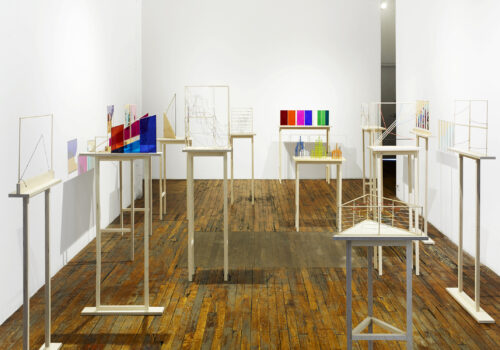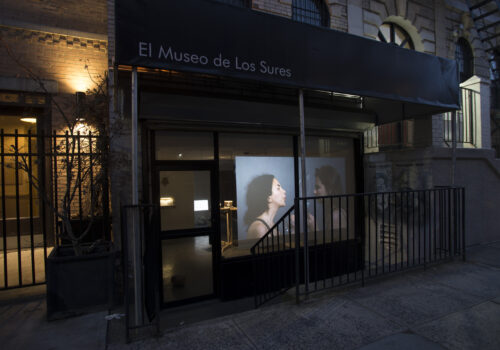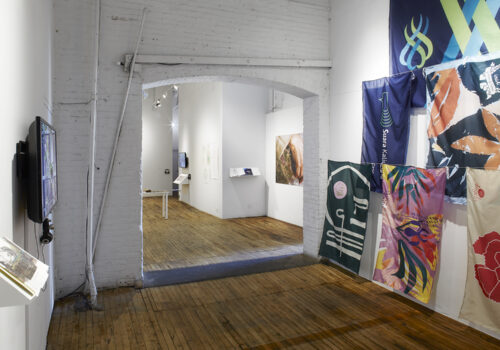Each year, ISCP presents a solo exhibition of a current resident, which gives rise to the ideal conditions for productive curatorial collaboration. 2016 saw the dynamic artistic duo of Richard Ibghy and Marilou Lemmens scheming together with Kari Conte, Director of Programs and Exhibitions, to create a deeply engaging onsite presentation of their sculptures in the exhibition “Measures of Inequity.” The following essay by Gentiane Bélanger was commissioned by ISCP on the occasion of the exhibition and gives a sense of the overall effect of the dense installation of 18 works, which invited sustained viewing and thinking, and reflection on the economic, national, and political implications raised by the delicate sculptures on view. Bélanger’s astute essay below is a foundational text that grounds and contextualizes the artists’ work.
Concrete Complexity: When Data Visualization Gets Put to the Test of Materiality
New media theorist Lev Manovich argues that big data visualization is to the twenty-first century what photography and film have been to the twentieth. Manovich considers big data visualization’s exponential rise over the past fifteen years as a profound epistemological and aesthetic paradigm shift, from a reductionist and linear approach to knowledge to an embrace of interconnected complexity.
[1] Essentially deriving from Cartesian geometry—with most charts conceived from a plane defined by x, y, and z axes—classic diagrammatic language tends however to interpret complex phenomena in a reductionist fashion. Most current data visualization follows this principle, as evidenced by the standards established by one of today’s foremost infographics theorists, Edward Tufte. Good infographic design, Tufte asserts, is a marvel of economy and spatialization, revealing data through a minimal layout uncluttered by contextual paraphernalia. For Tufte, best practices in information design amount to an act of distillation or excavation, removing all relativist and ornamental muck—what he terms
chartjunk—to get down to information’s objective bedrock. Diagrams should not be interpretive in themselves, but should rather support robust interpretation by visualizing connections between otherwise indecipherable data. “What is to be sought in designs for the display of information is the clear portrayal of complexity. Not the complication of the simple.”
[2]
Tufte’s reductionist view is expressed through nine principles of excellence governing “graphical elegance”:
- Show the data.
- Induce the viewer to think about the substance rather than about methodology, graphic design, the technology of graphic production, or something else.
- Avoid distorting what the data have to say.
- Present many numbers in a small space.
- Make large data sets coherent.
- Encourage the eye to compare different pieces of data.
- Reveal the data at several levels of detail, from a broad overview to the fine structure.
- Serve a reasonably clear purpose: description, exploration, tabulation, or decoration.
- Integrate closely with the statistical and verbal descriptions of a data set.[3]
But what if the reality apprehended is so intricate and complex that no distilled view can possibly do it justice? This is precisely the kind of challenge that big data presents, according to information designer Manuel Lima:
The complex connectedness of modern times requires new tools of analysis and exploration, but above all, it demands a new way of thinking. It demands a pluralistic understanding of the world that is able to envision the wider structural plan and at the same time examine the intricate mesh of connections among its smallest elements. It ultimately calls for a holistic systems approach; it calls for network thinking.
[4]
In what he terms “network visualization,” Lima evokes a new visual language, characterized by cluttered, multidimensional representations focused on data clusters and their myriad relations rather than on isolated data. Relational and systemic, network visualization is more related to discourses on rhizomatic structures, emergence, and complexity and chaos theories than to, say, Cartesianism. Similarly, art historian Susanne Leeb expands the understanding of graphic design theory, and more specifically the notion of the diagram, to include another view. Some, like Tufte, view the diagram as a tool for retrospective systematization by synthesizing and ordering myriad factors into a single analytical figure. Others perceive the diagram as a prospective, relational map in constant emergence. Leeb doesn’t see these two perspectives—retrospective and systematic versus prospective and evolutive—as mutually exclusive, but rather as inherent facets of the diagram that are always in tension. In other words, diagrams can be tools of systematization, but they can also become destabilizing agents of discovery.
[5] This heuristic understanding of the diagram aligns with Deleuzian thought. In an essay centred on Foucault’s philosophy, Deleuze states that the diagram never represents a pre-existing world but instead produces a new type of reality, a new model of truth. The diagram makes history by undoing preceding realities and significations, constituting so many points of emergence and creativity, unforeseen conjunctions, and improbable continuums. The diagram overrides history with new becomings.
[6]
Anthropologists Anthony McCosker and Rowan Wilken consider the current fascination with big data as an expression of the mathematical sublime.
[7] Within this proliferation of data, graphic designers become the new oracles, formulating graphic models that in turn shape our understanding of reality. They become the enunciators of knowledge and powerful visual rhetoricians. Just like language, data visualization can be used sophistically, tweaked into fallacious arguments. The longstanding debate around income inequality offers countless examples of such biased schematization. Take, for instance, Stephanie Evergreen’s argument on the misuse of color in data visualization and the incidental perpetuation of economic and racial inequalities.
[8] By abstracting complex realities and codifying them into graphic conventions, data visualization at its best has the power to reveal intangible realities; at its worst, to inflict symbolic violence.
In the economic theories probed by Richard Ibghy and Marilou Lemmens, diagrams reduce revenue flows, profit margins, labor forces, and the trading of resources to highly rationalized and hierarchized conceptual spaces. In economics diagrams take on a Foucauldian slant, their content susceptible to being used as a form of political technology, a device for control and governance situating subject and object in relation to one another and mapping out the shifting channels of power. Decision-making instances, for example—no longer rooted in bounded territories—now base their actions on an incommensurate heap of data denoting such parameters as gross domestic product, birth rate, life expectancy, national debt, currency value, and, of course, income disparity.
Against this backdrop, Ibghy & Lemmens give material form to charts and graphs culled from academic journals, essays, and conference proceedings in order to expose the arbitrariness of these visual languages and the extent of their power of abstraction. All that remains of the complexity of the realities represented by these charts are data that have been singled out and distributed across Cartesian grids. By questioning the strategies of representation employed by economists, Ibghy & Lemmens launch an epistemological inquiry into the construction of knowledge and the rhetorical power of data visualization. The works shown in
Measures of Inequity include replicated diagrams of the trickle-down theory, disparities in access to care for selected groups, and income inequality in emerging countries. Classical economics abstractions like the Lorenz Curve, which maps out the distribution of wealth, are meticulously—albeit imperfectly—rendered using thread or color acetate fixed to wood skewers or plywood and propped on makeshift tables. The delicate materiality and alluring aesthetics of these works somehow undermine the authority of the original data, exposing their narrative construction. As Murtaza Vali explains, “These material effects seem to soften the data—it becomes palatable and possibly even somewhat pliable, making the inequities measured no longer feel irreversible.”
[9]
The aesthetic connection between Ibghy & Lemmens’ corpus of works and avant-garde Modernism has been repeatedly observed. While in past projects, this citational trait suggested an overturning of the Russian Constructivist infatuation with progress and productivity,
[10] in
Measures of Inequity it takes on a new meaning. Productivity is a central point in the ongoing debate about economic inequality. If some politicians and economists like Newt Gingrich seem satisfied with macroeconomics, rounding off economic growth to the gross domestic product and viewing income inequality as a mere collateral effect, others instead emphasize the question of productivity. Such is the case with Nobel laureates Paul Krugman and Paul Stiglitz, both of whom distinguish between wealth generated through productive endeavour (start-ups, innovative working contexts, etc.) and what Gillian White describes as
rent-seeking: “the practice of increasing wealth by taking it from others rather than generating any actual economic activity.”
[11] The increased financialization of economics tilts the balance of wealth towards this register of economic activity to an unprecedented degree, to the detriment of the ninety-nine percent who are left out of the game.
Furthermore, when Stiglitz argues that income inequality creates “a society with a gaping hole, not only in its economic makeup, but in its morality,”
[12] he points to even harsher discrepancies, like unequal opportunity among marginalized groups. Krugman follows his lead by factoring in privilege:
“It would be foolish to deny that some people are, in fact, a lot more productive than average. It would be equally foolish, however, to deny that great success in business (or, actually, anything else) has a strong element of luck—not just the luck of being the first to stumble on a highly profitable idea or strategy, but also the luck of being born to the right parents.”
[13]
If the United States excels in economic inequality (what Krugman ironically defines as a case of American exceptionalism), the global scope of the Occupy Movement eloquently demonstrates how generalized this gap of opportunity has become. The Occupy Movement was a univocal outcry in response to the globalization and capital mobility that brought down wages globally, destroying many middle-income jobs while consolidating wealth in the hands of a few financial-market speculators. And, in an eternal return, women have recently marched on Washington, D.C., as the 45th president of the United States gets down to business at the White House flanked by his Goldman Sachs–affiliated cabinet, following a campaign bent on capitalizing on anti-establishment discourses and dismissing minority groups (if anyone other than male, white, and heterosexual can be properly termed a “minority”).
Like Donald Trump’s campaign, the diagrams craftily replicated by Ibghy & Lemmens point to the distillation of richly complex reality into a reductionist language. A sense of loss emanates from
Measures of Inequity: the loss of human richness, ambivalence, and singularity. In his essay “Against Infographics,” historian Daniel Rosenberg explains this:
“Anyone who uses data knows that clarity comes with trade-offs in many dimensions
. . . . We lose embeddedness. We lose traces of intention, local connections, and clues to what was hard and easy to understand—what needed explaining in the first place. The history of data graphics is a history of legends, cribs for reading, pointers on what is foreground and what is meant to stay to the back.”
[14]
Rosenberg goes on to appropriate and overturn Tufte’s principles of graphic excellence.
These
détournements aptly summarize the attitude adopted by Ibghy & Lemmens vis-à-vis data visualization:
- Show the graphics.
- Induce the viewer to think about the substance, methodology, design, technology, and aspects of production, dissemination, and consumption.
- Highlight the manipulation of data in every representation.
- Present many graphic elements in a small space.
- Attend to incoherencies in large data sets.
- Encourage the eye to compare different visual arrangements of the same subject.
- Reveal epistemological differences produced by changes of scale.
- Clarify the purposes and implications of data representations.
- Show how verbal and graphic devices interact in data representation.[15]
Ibghy & Lemmens take this undermining of infographics a step further by confronting visual abstractions with the stubborn presence of matter so as to reintegrate them into the complex matrix of reality. The craftsmanship and aesthetic savviness implied in these reconstitutions point to the constructed nature and rhetorical agenda of visualized knowledge. Far from merely reflecting reality, Ibghy & Lemmens reposition data visualization as a crafted conceptual apparatus able to compose new perspectives on reality and influence decisional power in tangible ways. As such, data visualization is structurally analogous to financial speculation. Both are radical forms of abstraction levelling down the world’s rich complexities, only to have greater influence on the unfolding of concrete matters. Reframing these abstracted systems within the contingencies of everyday materiality, Ibghy & Lemmens undermine their slick veneer of objectivity and expose their susceptibility to ideological bias in the form of cracks, gaps, makeshift collage, and exquisitely imperfect sculptures. The careful handling of materials, the confection of intricate and fragile forms, the aesthetic choices that are made by the artists all mirror—and undermine—the decisions, manipulations, and agendas that go into data visualization. Having passed through Ibghy & Lemmens’ hands, graphs and charts have to be taken for what they fundamentally are: elaborate, inventive, and value-laden narratives. Amazing how the mundane qualities of acetate, thread, and plywood have the capacity to annihilate the auratic authority of abstraction, and to let critical knowledge seep through their imperfect seams.
This essay is by Gentiane Bélanger, Director/Curator, Foreman Art Gallery of Bishop’s University, Sherbrooke, Quebec.
Image: Richard Ibghy & Marilou Lemmens, installation view of
Measures of Inequity, 2016. Photo by Martin Parsekian.
[1] Lev Manovich, foreword in
Visual Complexity: Mapping Patterns of Information, by Manuel Lima (New York: Princeton Architectural Press, 2011), 11-13.
[2] Edward Tufte,
The Visual Display of Quantitative Information, 2nd ed. (Cheshire: Graphics Press, 2001), 191.
[3] Ibid., 13.
[4] Manuel Lima,
Visual Complexity: Mapping Patterns of Information (New York: Princeton Architectural Press, 2011), 46.
[5] Susanne Leeb, “A Line with Variable Direction, which Traces No Contour, and Delimits No Form,” in
Drawing a Hypothesis: Figures of Thought, ed. Nikolaus Gansterer (Vienna: Springer-Verlag, 2011), 29-42.
[6] “Le diagramme ne fonctionne jamais pour représenter un monde préexistant, il produit un nouveau type de réalité, un nouveau modèle de vérité. […] Il fait l’histoire en défaisant les réalités et les significations précédentes, constituant autant de points d’émergence et de créativité, de conjonctions inattendues, de continuums improbables. Il double l’histoire avec un devenir.” Gilles Deleuze,
Foucault (Paris: Les Éditions de Minuit, 1986), 43.
[7] Anthony McCosker and Rowan Wilken, “Rethinking ‘big data’ as visual knowledge: the sublime and the diagrammatic in data visualisation,”
Visual Studies 29, no. 2 (2014): 155-164.
[8] “How Dataviz Can Unintentionally Perpetuate Inequality: The Bleeding Infestation Example,”
http://stephanieevergreen.com/dataviz-inequality_pt1/.
The example she points to consists of a map of households with an income under a certain threshold, which coincidentally correlates with neighbourhoods of minority groups. The data are visualized as red dots, making the zones of concentrated poverty resemble bleeding wounds or disease scars on the map. What was intended as mere information emerges instead as stigmatizing.
[9] Murtaza Vali, “Richard Ibghy and Marilou Lemmens,”
Artforum: Critics’ picks,
https://www.artforum.com/picks/id=63301.
[10] See Gentiane Bélanger, “Richard Ibghy & Marilou Lemmens: Putting Life to Work,”
C Magazine 131, Autumn 2016, 67-68.
[11] Gillian B. White, “Stiglitz: Here’s How to Fix Inequality,”
The Atlantic, November 2, 2015,
http://www.theatlantic.com/business/archive/2015/11/stiglitz-heres-how-to-fix-inequality/413761/.
[12] Ibid.
[13] Paul Krugman, “Is Vast Inequality Necessary?,”
The New York Times, January 15, 2016,
https://www.nytimes.com/2016/01/15/opinion/is-vast-inequality-necessary.html.
[14] Daniel Rosenberg, “Against Infographics,”
Art Journal 74, no. 4, Winter 2015, 56.
[15] Ibid., 57.]]>


